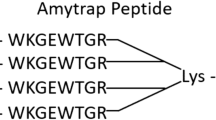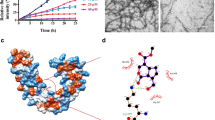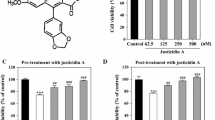Abstract
Alzheimer’s disease pathogenesis is measured by two key hallmarks viz extracellular senile plaques composed of insoluble amyloid beta (Aβ) and neurofibrillary tangles composed of hyperphosphorylated tau, resulting in microtubule destabilization, synaptic damage and neurodegeneration. Accumulation of Aβ is an introducing pathological incident in Alzheimer’s disease; hence, the effect of dimethyl fumarate (DMF) on Aβ1-42-induced alterations in phosphorylated tau, related protein kinases, fibrillogenesis and microtubule assembly in neuroblastoma SH-SY5Y cells was determined. DMF attenuated Aβ1-42-induced neuronal apoptosis by down-regulating protein levels of Bcl-2/Bax, cleaved caspase-3 and caspase-9. Aβ1-42-induced upsurge in tau phosphorylation at Ser396 and Thr231 epitopes was found to be declined by DMF pretreatment. The upregulated activity of glycogen synthase kinase-3 beta (GSK-3β) by Aβ1‑42 treatment was blocked by DMF pretreatment. PI3K substrate Akt (at Ser473) as well as Wnt dependent β-catenin and cyclin D1 activity was found to be upregulated by DMF pretreatment in Aβ1-42 treated cells. ThT fluorescence and MTT assay showed that DMF reduces Aβ fibrillogenesis and inhibit related cytotoxicity. Also, DMF exerts a protective effect on Aβ1-42-induced microtubule disassembly caused due to a reduction in polymerized β3-and α-tubulin. These results indicate that down-regulation of GSK-3β activity and subsequent activation of PI3K/Akt and Wnt/β-catenin signaling pathways are closely involved in the shielding effect of DMF against Aβ1-42-induced tau hyperphosphorylation. Modulating cellular events related to Aβ1-42-induced tau hyperphosphorylation, aggregation and microtubule stabilization offers new molecular insights into the defensive outcome of DMF towards appropriate management for Alzheimer’s disease.





Similar content being viewed by others
References
Bloom GS (2014) Amyloid-beta and tau: the trigger and bullet in Alzheimer disease pathogenesis. JAMA Neurol 71:505–508
Mietelska-Porowska A, Wasik U, Goras M, Filipek A, Niewiadomska G (2014) Tau protein modifications and interactions: their role in function and dysfunction. Int J Mol Sci 15:4671–4713
Iqbal K, Liu F, Gong CX (2015) Tau and neurodegenerative disease: the story so far. Nat Rev Neurol 12:15–27
Medina M, Garrido JJ, Wandosell FG (2011) Modulation of GSK-3 as a therapeutic strategy on tau pathologies. Front Mol Neurosci 4:24
Pascoal TA, Mathotaarachchi S, Shin M et al (2017) Synergistic interaction between amyloid and tau predicts the progression to dementia. Alzheimer’s Dement 13:644–653
Rambaran RN, Serpell LC (2008) Amyloid fibrils: abnormal protein assembly. Prion 2:112–117
Krishtal J, Bragina O, Metsla K, Palumaa P, Tougu V (2017) In situ fibrillizing amyloid-beta1-42 induces neurite degeneration and apoptosis of differentiated SH-SY5Y cells. PLoS ONE 12:e0186636
Parihar MS, Brewer GJ (2010) Amyloid-β as a modulator of synaptic plasticity. J Alzheimer’s Dis 22:741–763
Mota SI, Ferreira IL, Pereira C, Oliveira CR, Rego AC (2012) Amyloid-beta peptide 1–42 causes microtubule deregulation through N-methyl-D-aspartate receptors in mature hippocampal cultures. Cur Alzheimer Res 9:844–856
Yaari R, Hake A (2015) Alzheimer’s disease clinical trials: past failures future opportunities. Clin Invest 5:297–309
Majkutewicz I, Kurowska E, Podlacha M et al (2018) Age-dependent effects of dimethyl fumarate on cognitive and neuropathological features in the streptozotocin-induced rat model of Alzheimer’s disease. Brain Res 1686:19–33
Kappos L, Giovannoni G, Gold R et al (2015) Time course of clinical and neuroradiological effects of delayed-release dimethyl fumarate in multiple sclerosis. Eur J Neurol 22:664–671
Campolo M, Casili G, Lanza M et al (2018) Multiple mechanisms of dimethyl fumarate in amyloid β-induced neurotoxicity in human neuronal cells. J Cell Mol Med 22:1081–1094
Dahlgren KN, Manelli AM, Stine WB Jr et al (2002) Oligomeric and fibrillar species of amyloid-beta peptides differentially affect neuronal viability. J Biol Chem 277:32046–32053
Joshi HC, Cleveland DW (1989) Differential utilization of beta-tubulin isotypes in differentiating neurites. J Cell Biol 109:663–673
Walker JM (1996) The bicinchoninic acid (BCA) assay for protein quantitation. In: Walker JM (ed) The protein protocols handbook. Springer protocols Handbooks. Humana Press, Totowa
Omar SH, Scott CJ, Hamlin AS, Obied HK (2019) Olive biophenols reduces Alzheimer’s pathology in SH-SY5Y cells and APPswe mice. Int J Mol Sci 20:125
Sun ZK, Yang HQ, Pan J et al (2008) Protective effects of erythropoietin on tau phosphorylation induced by β-amyloid. J Neurosci Res 86:3018–3027
Cao M, Liu F, Ji F et al (2013) Effect of c-Jun N-terminal kinase (JNK)/p38 mitogen-activated protein kinase (p38 MAPK) in morphine-induced tau protein hyperphosphorylation. Behav Brain Res 237:249–255
Engel T, Hernandez F, Avila J, Lucas JJ (2006) Full reversal of Alzheimer's disease-like phenotype in a mouse model with conditional overexpression of glycogen synthase kinase-3. J Neurosci 26:5083–5090
Li S, Jin M, Koeglsperger T et al (2011) Soluble Abeta oligomers inhibit long-term potentiation through a mechanism involving excessive activation of extrasynaptic NR2B containing NMDA receptors. J Neurosci 31:6627–6638
Eleanor D, Wisniewski T (2017) Alzheimer’s disease: experimental models and reality. Acta Neuropathol 133:155–175
Jang JH, Surh YJ (2004) Bcl-2 protects against Abeta (25–35)-induced oxidative PC12 cell death by potentiation of antioxidant capacity. Biochem Biophys Res Commun 320:880–886
Wang C, Youle RJ (2009) The role of mitochondria in apoptosis. Annu Rev Genet 43:95–118
Yao M, Nguyen TV, Pike CJ (2005) Beta-amyloid-induced neuronal apoptosis involves c-Jun N-terminal kinase-dependent downregulation of Bcl-w. J Neurosci 25:1149–1158
Du Q, Geller DA (2010) Cross-regulation between Wnt and NF-κB signaling pathways. Immunopathol Dis Therap 1:155–181
Du Y, Du Y, Zhang Y et al (2019) MKP-1 reduces Aβ generation and alleviates cognitive impairments in Alzheimer’s disease models. Sig Transduct Target Ther 4:58
Jin Y, Fan Y, Yan EZ (2006) Effects of sodium ferulate on amyloid-beta-induced MKK3/MKK6-p38 MAPK-Hsp27 signal pathway and apoptosis in rat hippocampus. Acta Pharmacol Sin 27:1309–1316
Peng H, Guerau-de-Arellano M, Mehta VB et al (2012) Dimethyl fumarate inhibits dendritic cell maturation via nuclear factor κB (NF-κB) and extracellular signal-regulated kinase 1 and 2 (ERK1/2) and mitogen stress-activated kinase 1 (MSK1) signaling. J Biol Chem 287:28017–28026
Silva-Alvarez C, Arrazola MS, Godoy JA, Ordenes D, Inestrosa NC (2013) Canonical Wnt signaling protects hippocampal neurons from Aβ oligomers: role of non-canonical Wnt-5a/Ca(2+) in mitochondrial dynamics. Front Cell Neurosci 7:97
Arrazola MS, Silva-Alvare C, Inestrosa NC (2015) How the Wnt signaling pathway protects from neurodegeneration: the mitochondrial scenario. Front Cell Neurosci 9:166
Kisoh K, Hayashi H, Itoh T et al (2017) Involvement of GSK-3β phosphorylation through PI3-K/Akt in cerebral ischemia-induced neurogenesis in rats. Mol Neurobiol 54:7917–7927
Xian XF, Qing-Qiu M, Justin CY et al (2014) Isorhynchophylline treatment improves the amyloid-β-induced cognitive impairment in rats via inhibition of neuronal apoptosis and tau protein hyperphosphorylation. J Alzheimer’s Dis 39:331–346
Toyama T, Looney AP, Baker BM et al (2018) Therapeutic targeting of TAZ and YAP by dimethyl fumarate in systemic sclerosis fibrosis. J Invest Dermatol 138:78–88
Cuadrado A, Kugler S, Lastres-Becker I (2018) Pharmacological targeting of GSK-3 and NRF2 provides neuroprotection in a preclinical model of tauopathy. Redox Biol 14:522–534
Henriques AG, Vieira SI, daCruz E et al (2010) Abeta promotes Alzheimer's disease-like cytoskeleton abnormalities with consequences to APP processing in neurons. J Neurochem 113:761–771
Zabrecky JR, Cole RD (1982) Effect of ATP on the kinetics of microtubule assembly. J Biol Chem 257:4633–4638
Marshall KE, Marchante R, Xue WF, Serpell LC (2014) The relationship between amyloid structure and cytotoxicity. Prion 8:192–196
Wolfe LS, Calabrese MF, Nath A, Blaho DV, Miranker AD, Xiong Y (2010) Protein-induced photophysical changes to the amyloid indicator dye thioflavin T. PNAS USA 107:16863–16868
Kees F (2013) Dimethyl fumarate: a Janus-faced substance? Expert Opin Pharmacother 14:1559–1567
Demuro A, Parker I (2013) Cytotoxicity of intracellular Aβ42 amyloid oligomers involves Ca2+ release from the endoplasmic reticulum by stimulated production of inositol trisphosphate. J Neurosci 33:3824–3833
Huang H, Taraboletti A, Shriver LP (2015) Dimethyl fumarate modulates antioxidant and lipid metabolism in oligodendrocytes. Redox Biol 5:169–175
Herrmann AK, Wullner V, Moos S et al (2019) Dimethyl fumarate alters intracellular Ca2+ handling in immune cells by redox-mediated pleiotropic effects. Free Radic Biol Med 141:338–347
Enache TA, Oliveira-Brett AM (2017) Alzheimer's disease amyloid beta peptides in vitro electrochemical oxidation. Bioelectrochemistry 114:13–23
Acknowledgements
This research work was financially supported under SERB-National Postdoctoral Fellowship scheme, funded by Science and Engineering Research Board (SERB), Department of Science and Technology (DST), Government of India, New Delhi, India and the corresponding author is recipient of the Postdoctoral Fellowship (File No. PDF/2017/002802) from SERB, DST, India.
Author information
Authors and Affiliations
Contributions
Conceptualization: MSR; Methodology: MSR, DR; Formal analysis and investigation: MSR, NPN; Writing—original draft preparation: MSR; Writing—review and editing: MSR, NPN, RD; Funding acquisition: MSR; Resources: MSR, DR, RD; Supervision: NPN, RD.
Corresponding author
Ethics declarations
Conflict of interest
We declare that we do not have any conflict of interest.
Additional information
Publisher's Note
Springer Nature remains neutral with regard to jurisdictional claims in published maps and institutional affiliations.
Electronic supplementary material
Below is the link to the electronic supplementary material.
Rights and permissions
About this article
Cite this article
Rajput, M.S., Nirmal, N.P., Rathore, D. et al. Dimethyl Fumarate Mitigates Tauopathy in Aβ-Induced Neuroblastoma SH-SY5Y Cells. Neurochem Res 45, 2641–2652 (2020). https://doi.org/10.1007/s11064-020-03115-x
Received:
Revised:
Accepted:
Published:
Issue Date:
DOI: https://doi.org/10.1007/s11064-020-03115-x




